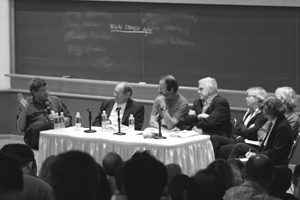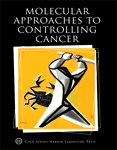|
LXX: Molecular Approaches to Controlling Cancer 2005 |
|
|

|
Cancer Genome Project Discussion Panel (l-r) E. Lander, S. Brenner, H. Varmus, B. Alberts, J. Brugge, J. Peterson, A. Barker; C. Prives SYMPOSIUM SYNOPSIS LIST OF PARTICIPANTS CONTENTS OF SYMPOSIUM VOLUME PHOTOGRAPHS PUBLISHED VOLUME  |
Molecular Approaches to Controlling Cancer
May 28 - June 2, 2005
Symposium Synopsis
Meeting Organized by Bruce Stillman and David Stewart
During the past quarter century or so, much effort has been devoted toward the understanding of the molecular basis of cancer. We now understand that cancer is primarily a genetic disease of mutations in the tumor genome acquired over a lifetime. The products of oncogenes and tumor suppressor genes have been placed into pathways of gene networks that are altered in tumor cells compared to normal cells in tissue. Furthermore, we also understand that tumors function as abnormal organs, forming an architecture of a number of different cell types and recruiting a blood supply, albeit an irregular one. There have been many Symposia in this series that dealt with cancer directly, and even more that focused on basic biology that contributed greatly to understanding cancer.
As a result of some interesting developments in cancer diagnosis and therapy over the past five years, it was appropriate that a Symposium be devoted for the first time to molecular approaches to cancer therapy. Several examples now exist of targeted therapy that works in patients that have been profiled based on genetic diagnosis of the patient's tumor. Additionally, therapies targeting the tumor as an organ, such as anti-angiogenic therapy, are now used in the clinic with modest success. The hope is that this type of molecular approach to cancer therapy will accelerate and become more effective in the future.
In organizing this Symposium with help from Terri Grodzicker, we relied on the assistance of a number of colleagues for suggestions for speakers. They included David Livingston, Craig Thompson, and Scott Lowe, and we thank them for their valuable advice. We also thank the first evening speakers, Dennis Slamon, Harold Varmus, Mina Bissell, and Jim Allison, for providing an overview of the areas to be covered. This year's Reginald Harris Lecture was delivered by Titia de Lange on telomere biology and genomic stability. We particularly thank Tyler Jacks for delivering a thoughtful and realistic summary of where we are in relation to our goal. Charles Sawyers, who conveyed the excitement which many of us feel knowing that some inroads into treating cancer will be made by targeted therapies, presented the Dorcas Cummings Lecture to the local community and the attending scientists. The effort put into the Dorcas Cummings Lecture by Charles and the summary by Tyler resulted in highlights of the meeting.
This Symposium was attended by 515 scientists and clinicians, and the program included 71 oral presentations and 241 poster presentations. Bruce Alberts chaired a discussion of the proposal to analyze the genomes of all major human cancers to advance cancer diagnosis and therapy approaches.
Essential funds to run this meeting were obtained from the National Cancer Institute, a branch of the National Institutes of Health. In addition, financial help from the corporate benefactors, sponsors, affiliates, and contributors of our meetings program is essential for these Symposia to remain a success, and we are most grateful for their continued support.
We thank Val Pakaluk and Mary Smith in the Meetings and Courses office for their efficient help in organizing the Symposium. Joan Ebert, Patricia Barker, and Susan Schaefer in the Cold Spring Harbor Laboratory Press, headed by John Inglis, ensured that this volume would be produced. We thank them for their dedication to producing high-quality publications.
Bruce Stillman
David Stewart
April 2006
Search images: